I have an art quiz later today so I'm going to do a post all about art. Who says blogging can't be productive?
Part 1: Basic Elements
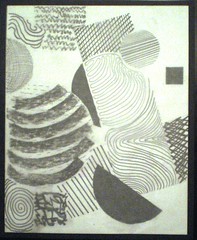 1. Line: The distance between two points, or the pathway of a moving point. Line can have endless characteristics such as thin, thick, wavy, broken, implied (-- --- --- --- --- ---), psychic (line of sight), contour (the edge of a shape), calligraphic, etc.
1. Line: The distance between two points, or the pathway of a moving point. Line can have endless characteristics such as thin, thick, wavy, broken, implied (-- --- --- --- --- ---), psychic (line of sight), contour (the edge of a shape), calligraphic, etc.
2. Shape: A flat, 2-dimensional enclosed line. Possessing width and height.
3. Form: Round, 3-dimensional figure, possessing width, height and depth.
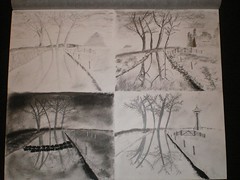 4. Value: Amount of lights and darks. The upper left corner is high value, minor contrast. Top right is intermediate value, minor contrast. Bottom left is low-minor and bottom right is high-major.
4. Value: Amount of lights and darks. The upper left corner is high value, minor contrast. Top right is intermediate value, minor contrast. Bottom left is low-minor and bottom right is high-major.
5. Texture: The surface character of a material that can be experienced through touch or the illusion of touch. Tactile texture is stuff you can touch. Simulated texture is a convincing copy or translation of an object's surface in any medium. For this assignment, we spent time in class drawing invented textures on an outline of our hands. Then we took various rubbings of surfaces around school and then had to use a certain number of each type of texture to create a composition. I used bubbly, prickly, scaley, smooth invented finger textures as well as the sole of a shoe and some other things.
6. Space: Flat, shallow or deep. Positive space is occupied space; objects and most dominant areas. Negative space is less dominant, unoccupied space. One of the innovations of cubism, invented by Picasso and George Braque, was to portray more than one perspective of an object at the same time. For our assignment, we made five different viewpoint drawings of a small, interesting object on trace paper. Then the drawings were layered and we drew a whole new shape from the intersecting drawings. This was done three times, one a line drawing, one shaded in black and white for a flat design and one shaded to look three dimensional and give depth. Any guesses as to what my original object was?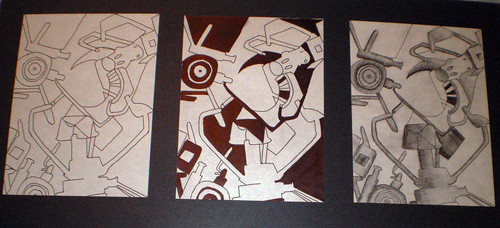
Part 2: Principles of Design
1. Balance: A sense of visual equilibrium achieved through implied weight, attention or attraction, by manipulating the elements in a composition.
Symmetrical Balance is the exact duplication of appearances in mirror-like repetition on either side of an imaginary line down the center of the composition.
Asymmetrical: A composition which is visually balanced, but does not have the same exact elements on each side.
Approximate Symmetry: The use of similar imagery on either side of a central axis.
Radial: Parts of a design seem to emanate toward or away from a central point.
This week's homework on balance was to take three differently balanced designs and distill the basic shapes into a non-objective design which obscures the original reference. New design did not have to have the same type of balance as the original.
2. Proportion: The relationship in scale between one element and another or between a whole and one of it's parts. Proportion refers to a comparison of sizes or parts of a whole (Is the head in proportion to the body?). Scale is established when associations of size are measured relative to human dimensions. Monumental, miniature, life-sized, exaggerated and idealized.
3. Repetition/Pattern: The use of the same visual effect a number of times in the same composition.
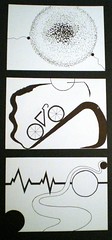 4. Unity/Harmony: The quality of one-ness, of individual elements relating to the whole in a composition. Assignment: Make three unified designs using ONLY three circles and two lines.
4. Unity/Harmony: The quality of one-ness, of individual elements relating to the whole in a composition. Assignment: Make three unified designs using ONLY three circles and two lines.
5. Rhythm: A flow or sense of movement achieved by repetition of regulated visual units. Rhthym results from the perception of intervals between repeated elements.
6. Dominance/Focal point: The perceived focus of interest. Visual emphasis in a work of art is a way of calling our attention to a particular area. Dominance--making one element the strongest (brightest color, unique shape). Focal point: An isolated element, larger or smaller in size, contrast, having lines or paths that come together.
7. Variety: Differences achieved by the use of unexpected, opposing, contrasting, changing or diversifying elements to add interest.
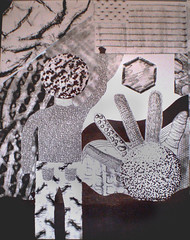


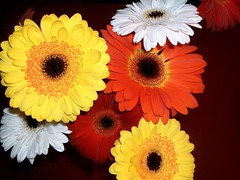
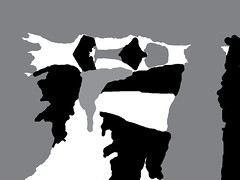

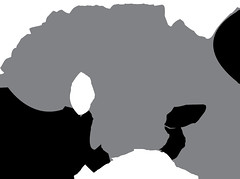

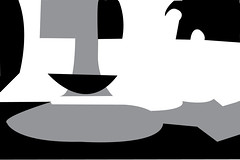


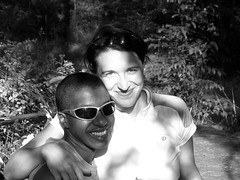


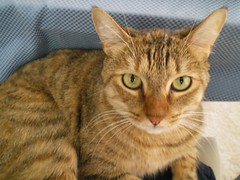


2 comments:
I like your examples, and hope you recieved a good grade for them!
I did, thanks!
Post a Comment